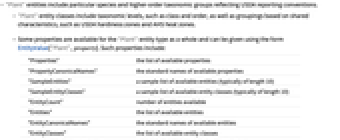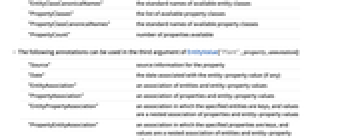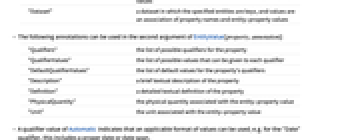-
See Also
- EntityType
- Entity
- EntityClass
- EntityList
- EntityProperties
-
- Entity Types
- TaxonomicSpecies
- TaxonomicRank
- CultivatedPlant
- CultivatedPlantType
- USDAPlantShadeTolerance
- USDASoilTexture
- USDAPlantHardinessZone
- AHSPlantHeatZone
- PlantEarliness
- PlantGrowthForm
- PlantHeredity
- PlantLeafRetention
- PlantLifeCycle
- PlantPhysiologicalResistance
- PlantPollinator
- PlantPropagationMethod
- PlantSoilMoisturePreference
- PlantStructure
- PlantSunRequirement
- PlantUse
- SpeciesColor
- SpeciesTemporalConcept
- BiogeographicRegion
- Biome
- Virus
- Dinosaur
- DogBreed
- CatBreed
- HorseBreed
- CattleBreed
- GoatBreed
- PigBreed
- PoultryBreed
- PigeonBreed
- SheepBreed
-
- Interpreter Types
- TaxonomicSpecies
- Plant
- ComputedPlant
-
- Text Contents
- Plant
- Related Guides
-
-
See Also
- EntityType
- Entity
- EntityClass
- EntityList
- EntityProperties
-
- Entity Types
- TaxonomicSpecies
- TaxonomicRank
- CultivatedPlant
- CultivatedPlantType
- USDAPlantShadeTolerance
- USDASoilTexture
- USDAPlantHardinessZone
- AHSPlantHeatZone
- PlantEarliness
- PlantGrowthForm
- PlantHeredity
- PlantLeafRetention
- PlantLifeCycle
- PlantPhysiologicalResistance
- PlantPollinator
- PlantPropagationMethod
- PlantSoilMoisturePreference
- PlantStructure
- PlantSunRequirement
- PlantUse
- SpeciesColor
- SpeciesTemporalConcept
- BiogeographicRegion
- Biome
- Virus
- Dinosaur
- DogBreed
- CatBreed
- HorseBreed
- CattleBreed
- GoatBreed
- PigBreed
- PoultryBreed
- PigeonBreed
- SheepBreed
-
- Interpreter Types
- TaxonomicSpecies
- Plant
- ComputedPlant
-
- Text Contents
- Plant
- Related Guides
-
See Also
Plant
![]() [prop]
[prop]
gives the value of a specified property.
![]() [{propi,…}]
[{propi,…}]
gives the value of a list of properties.
![]() [prop,{qualivali,…}]
[prop,{qualivali,…}]
gives the value of a specified property modified by qualifier rules quali->vali.
![]() [Dated[prop,date]]
[Dated[prop,date]]
gives the value of a property associated with a particular date specification.
EntityClass["Plant",{propispeci,…}]
represents a class of entities with values of propi defined by speci.
Sample Entities
-

















































 …
…
Sample Entity Classes
-









 …
…
Properties










-
ActiveGrowthPeriod active growth period AdaptedToCoarseTexturedSoilsQ adapted to coarse textured soils AdaptedToFineTexturedSoilsQ adapted to fine textured soils AdaptedToMediumTexturedSoilsQ adapted to medium textured soils AfterHarvestRegrowthRate after harvest regrowth rate AlternateCommonNames alternate common names AlternateScientificNames alternate scientific names AnaerobicTolerance anaerobic tolerance AreaPerPlantRange area per plant range BerryNutSeedProductQ berry nut seed product BinomialAuthor binomial author Bloat bloat BloomPeriod reproductive period CalciumCarbonateTolerance calcium carbonate tolerance CarbonNitrogenRatio carbon nitrogen ratio ChristmasTreeProductQ christmas tree product ColdStratification cold stratification COLNameCode COL name code COLNumber COL number CommercialAvailability commercial availability CommonName common name CoppicePotentialQ coppice potential CountryList country distribution list DroughtTolerance drought tolerance Duration natural life cycle EntityClasses entity classes EntityTypeList entity type list FallConspicuousQ fall conspicuous FederalNoxiousStatus federal noxious status FederalTEStatus federal TE status FertilityRequirement fertility requirement FireResistantQ fire resistant FireTolerance fire tolerance FlowerColor flower color FlowerConspicuousQ flower conspicuous FodderProductQ fodder product FoliageColor foliage color FoliagePorositySummer foliage porosity summer FoliagePorosityWinter foliage porosity winter FoliageTexture foliage texture FruitColor fruit color FruitConspicuousQ fruit conspicuous FruitSeedAbundance fruit/seed abundance FruitSeedBeginPeriod fruit/seed begin period FruitSeedEndPeriod fruit/seed end period FuelwoodPotential fuelwood potential GerminationTemperature germination temperature GerminationTime germination time GrowthHabit growth form GrowthRate growth rate GrowthRequirementGroups soil texture requirements HedgeTolerance pruning tolerance Image image ITISTSN ITIS TSN KnownAllelopathQ known allelopath LeafRetentionQ leaf retention Lifespan lifespan LocalOccurrence natural occurrence LowGrowingGrassQ low growing grass LumberProductQ lumber product MatureHeight mature height MatureHeightBaseAgeMaximum maximum mature height at base age MaximumAreaPerPlant maximum area per plant MaximumpH maximum pH MaximumPlantingDensityPerAcre maximum planting density MaximumPrecipitation maximum precipitation MinimumAreaPerPlant minimum area per plant MinimumFrostFreeDays minimum frost free days MinimumpH minimum pH MinimumPlantingDensityPerAcre minimum planting density MinimumPrecipitation minimum precipitation MinimumRootDepth minimum root depth MinimumTemperature minimum tolerable temperature MoistureUse moisture use Name name NationalWetlandStatus national wetland status NavalStoreProductQ naval store product NitrogenFixation nitrogen fixation NumberOfSubEntities number of child taxa NurseryStockProductQ nursery stock product OptimalTemperatureRange optimal temperature range PalatableBrowseAnimal palatable to browsing animals PalatableGrazeAnimal palatable to grazing animals PalatableHuman human palatability PalatableHumanQ palatable to humans ParentEntity parent taxon PersistentFruitSeed fruit/seed persistence PHRange pH range PlantHardinessZone USDA hardiness zone PlantHeatZone AHS heat zone PlantingDensityPerAcreRange planting density range PostProductQ post product PrecipitationRange precipitation range PropagatedByBareRootQ propagated by bare root PropagatedByBulbsQ propagated by bulbs PropagatedByContainerQ propagated by container PropagatedByCormsQ propagated by corms PropagatedByCuttingsQ propagated by cuttings PropagatedBySeedQ propagated by seed PropagatedBySodQ propagated by sod PropagatedBySprigsQ propagated by sprigs PropagatedByTubersQ propagated by tubers ProteinPotential protein potential ProvinceList Canadian province distribution list PulpwoodProductQ pulpwood product QuadrinomialAuthor quadrinomial author RegionalWetlandStatus regional wetland status ReproductionGroups method of propagation ResproutAbilityQ resprout ability SalinityTolerance salinity tolerance ScientificName scientific name SeedlingVigor seedling vigor SeedsPerPound seed count SeedSpreadRate seed spread rate ShadeTolerance shade tolerance ShapeAndOrientation shape and orientation Siblings sibling taxa SmallGrain small grain StateList U.S. state distribution list SubEntities child taxa SuitabilityGroups uses Synonyms synonyms TaxonomicLevel taxonomic level TaxonomicSequence taxonomic sequence TaxonomyGraph taxonomy graph Toxicity toxicity TrinomialAuthor trinomial author USDAAcceptedSymbol USDA accepted symbol USDAClass USDA class USDADivision USDA division USDAFamily USDA family USDAForma USDA forma USDAGenus USDA genus USDAGeographicDistribution USDA geographic distribution USDAKingdom USDA kingdom USDAOrder USDA order USDASpecies USDA species USDASubclass USDA subclass USDASubdivision USDA subdivision USDASubkingdom USDA subkingdom USDASubspecies USDA subspecies USDASuperdivision USDA superdivision USDASymbol USDA symbol USDAVariety USDA variety VegetativeSpreadRate vegetative spread rate VeneerProductQ veneer product
Details



- "Plant" entities include particular species and higher-order taxonomic groups reflecting USDA reporting conventions.
- "Plant" entity classes include taxonomic levels, such as class and order, as well as groupings based on shared characteristics, such as USDA hardiness zones and AHS heat zones.
- Some properties are available for the "Plant" entity type as a whole and can be given using the form EntityValue["Plant",property]. Such properties include:
-
"Properties" the list of available properties "PropertyCanonicalNames" the standard names of available properties "SampleEntities" a sample list of available entities (typically of length 10) "SampleEntityClasses" a sample list of available entity classes (typically of length 10) "EntityCount" number of entities available "Entities" the list of available entities "EntityCanonicalNames" the standard names of available entities "EntityClasses" the list of available entity classes "EntityClassCanonicalNames" the standard names of available entity classes "PropertyClasses" the list of available property classes "PropertyClassCanonicalNames" the standard names of available property classes "PropertyCount" number of properties available - The following annotations can be used in the third argument of EntityValue["Plant",property,annotation]:
-
"Source" source information for the property "Date" the date associated with the entity-property value (if any) "EntityAssociation" an association of entities and entity-property values "PropertyAssociation" an association of properties and entity-property values "EntityPropertyAssociation" an association in which the specified entities are keys, and values are a nested association of properties and entity-property values "PropertyEntityAssociation" an association in which the specified properties are keys, and values are a nested association of entities and entity-property values "Dataset" a dataset in which the specified entities are keys, and values are an association of property names and entity-property values - The following annotations can be used in the second argument of EntityValue[property,annotation]:
-
"Qualifiers" the list of possible qualifiers for the property "QualifierValues" the list of possible values that can be given to each qualifier "DefaultQualifierValues" the list of default values for the property's qualifiers "Description" a brief textual description of the property "Definition" a detailed textual definition of the property "PhysicalQuantity" the physical quantity associated with the entity-property value "Unit" the unit associated with the entity-property value - A qualifier value of Automatic indicates that an applicable format of values can be used; e.g. for the "Date" qualifier, this includes a proper date or date span.
Examples
open all close allBasic Examples (3)
Use ![]() for entity discovery:
for entity discovery:
Find a property value for an entity:
Retrieve a dataset of all available properties for an entity:
See Also
EntityType ▪ Entity ▪ EntityClass ▪ EntityList ▪ EntityProperties
Entity Types: TaxonomicSpecies TaxonomicRank CultivatedPlant CultivatedPlantType USDAPlantShadeTolerance USDASoilTexture USDAPlantHardinessZone AHSPlantHeatZone PlantEarliness PlantGrowthForm PlantHeredity PlantLeafRetention PlantLifeCycle PlantPhysiologicalResistance PlantPollinator PlantPropagationMethod PlantSoilMoisturePreference PlantStructure PlantSunRequirement PlantUse SpeciesColor SpeciesTemporalConcept BiogeographicRegion Biome Virus Dinosaur DogBreed CatBreed HorseBreed CattleBreed GoatBreed PigBreed PoultryBreed PigeonBreed SheepBreed
Interpreter Types: TaxonomicSpecies Plant ComputedPlant
Text Contents: Plant
Related Guides
History
Introduced in 2019 (12.0)